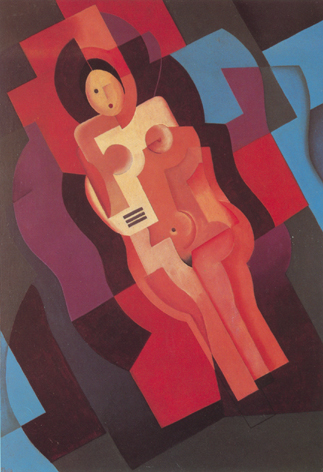

FILLIA
"FEMMINILITA"
TEMPERA ON PAPER ON CANVAS, SIGNED
ITALY, PAINTED 1928
CLICK HERE TO SEE RECENTLY ACQUIRED PAINTINGS
Luigi Colombo. Later known as Filia, was born in Revllo, Italy in 1904. After Prampolini, he was the true innovator of the second generation of Futurism. In 1923, at the age of nineteen, he established the Futurist movement in Turin,, with a group which included Diulgheroff, Oriani, Alimandi, Costa, and the sculptor mino Rossi. Filia quickly became the indefatigable driving force behind the group, not only as an artist, but as an artistic theorist. He worked with and guided vibrant young artists, and launched the art reviews: Futurismo (1924), Ventrina Futurista (1927), La Citta Futurista (1929), La Citta Nuova (1930-1934), and Sitle Futurista (1934-1935) in collaboration with Prampolini.
While Filia's work of the mid-1920's shows the influence of Prampolini's mechanical style, it also reveals his fascination with psychology, as in Femminilitå of 1928. He became a devoted enthusiast of L'Aeropittura,” which applied the principal theories of Futurism to the visual experience of viewing a landscape aerially; the world was no longer seen from the perspective of ordinary man, which allowed the Futurists new cosmic explorations, and a further break from traditional figuration.
After 1928, Filia showed and increasing subjectivity in his work. In 1929, he published the Futurist manifesto L'Aeropittura, which also bore the signature of Benedetta, Depero, Dottori, Marinetti, Somenzi, Tato, and Prampolini. Albino Galvano has pointed out that by rallying with enthusiasm to Prampolini's new ideas, the artists in the Turin group showed themselves faithful to the deep spirit of Futurism; they contributed to express the artistic voice of the work of the first Futurists. However, as Enrico Crispolti pointed out, contrary to the objectivity of Prampolini's vision, or of Depero's , “the common denominator in the work of Filia, Oriani, and the Alimandi is the order of an exploration entirely interior, psychological, and extremely subjective.” Filia felt that rather than translating the “airy sensibility” by means of “arbesques and the rhythm of forms,” he has recourse to an “airy body,” a “synthesis of movement, of the organic aspect, of the emotions of flight.” In fact, if the ectoplasmic forms which appear in Filia's paintings of the late twenties and early thirties contrast with the rigidity of Filia's earlier paintings, it is not by an abandon of the facility, but by a decided willingness to explore the dictates of the subconscious.
In addition to the cosmic sphere, Filia was inspired to create landscapes and representation of couples. In his work of the 1930's, the forms often have a certain heaviness that compensates for the explosion of colors, or the solidity of the scheme. He developed and attraction to mysticism that resulted in the Manifesto of Sacred Futurist Art, which he signed with Marinetti in 1932. He also explored an interest in architecture; in 1928, he designed the Futurist Pavilion at the International Exhibition in Turin.
Filia's activities as an organizer and polemicist, which he continued through his contact with the avant-garde in his numerous trips to Paris, only ended with his death in 1936, at the age of thirty-two. Filia's paintings are in the collections of the Galleria d'Arte Moderna in Rome, the Galleria d'Arte Moderna In Turin, and in a number of private collection.